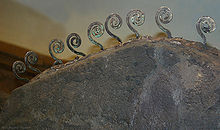Ladby ship
It is of the type also represented by the boat chamber grave of Hedeby and the ship burials of Oseberg, Borre, Gokstad and Tune in South Norway, all of which date back to the 9th and 10th centuries.
It has been dated to the early 10th century, based on a gilded link of bronze for a dog-harness, decorated in the Jelling style, found there.
Since only a few small human bones were found, researchers have concluded that the site is a translation, a conversion from a heathen to a Christian grave [citation needed].
Another interpretation is that the struggle for dominance by King Haraldr Blátönn and his heir, Sveinn Tjúguskegg, may have led to the grave's desecration [citation needed].
By removing the deceased and chopping all his grave goods into hundreds of pieces within a few years of the burial, the attackers presumably gave his heirs a great blow to their family prestige [citation needed].
The site was discovered on or around February 28, 1935, near Kerteminde in northeastern Fyn, Denmark, by pharmacist and amateur archaeologist Poul Helweg Mikkelsen.
Original drawings by Mikkelsen and Danish National Museum conservator Gustav Rosenberg constitute the primary source-material for information on the find [citation needed].
Mikkelsen paid for an arched building to be raised above the site, which was then covered with earth and grass [citation needed].
[1] First, ship burial sites are often found on higher terrain, hilltops, slopes, and beach ridges.
Second, ship burial sites are usually found in close proximity to the water, whether it be a lake, a fjord, or the sea.
During excavation, Rosenberg kept detailed journals that are still considered the most important source of information regarding the ship and its contents.
[19] Rosenberg was more the specialist in his writing, using more colloquial language, while Mikkelsen's reflections are more emotional and focused on the discovery of the ship.
[24] Rosenberg and Mikkelsen agreed that the stem, with its ornamentation, was meant to symbolize the mane on an animal, a dragon in particular, whose head had rotted away.
[36] While digging from the west part towards the middle of the ship to search for timber, Rosenberg noticed that the wood of the strakes was extant only where it had been in contact with iron.
[42] A horizontal layer of reddish wood was discovered at 12–15 meters, which must have been part of a deck-layer of planks that had collapsed, lying undisturbed above the west side of the ship.
Below this layer of wood, between 11 and 13 meters, they found threads of a fibrous organic material that did not seem to be woven, but which could not be positively identified (Sørensen, 31).
[44] Mikkelsen's journal also notes that large pieces of wood appeared to be missing from the eastern side of the ship.
[52] The anchor was located on the port side, right forward in the prow, with the shank in a roughly horizontal position pointing backwards towards the stern.
[60] Cleaning the chain revealed that the individual links—which unlike the exposed links still contain a high percentage of iron—are not the same size.
It shows the scene as it may have looked right after the funeral, with the deceased chieftain lying on a bed in a full-scale replica of his ship, with all his grave goods, near his dogs and his eleven horses.
There is also an interpretive movie about the Vikings' beliefs regarding the journey to the realm of the dead, based on Norse myths and the images on the Gotlandic Picture stones.






